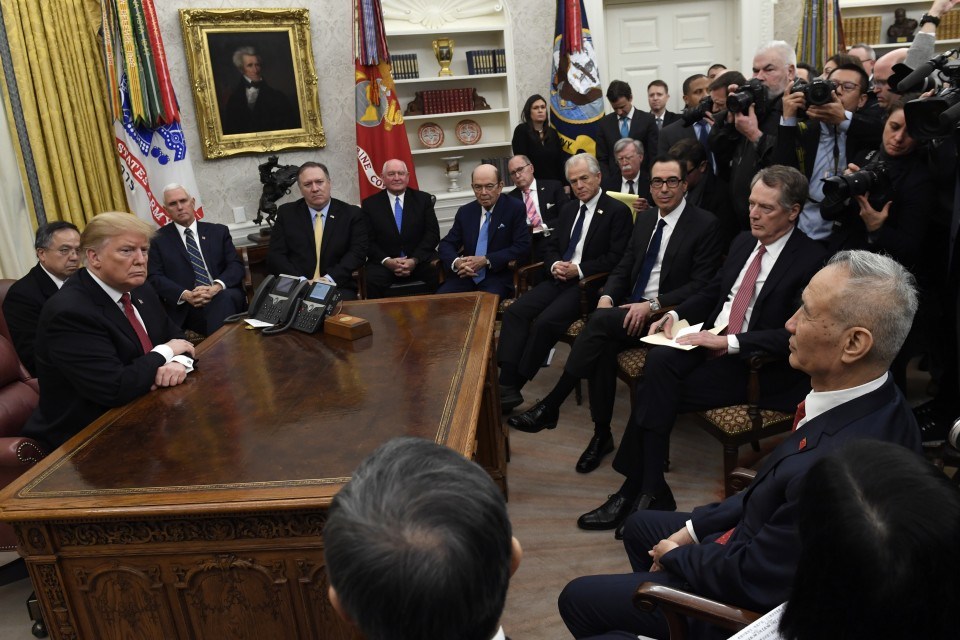Michael Froman served as the U.S. Trade Representative from 2013-2017.
Last week, the Trump administration came to the trade talks with China armed with significant potential negotiating leverage. The $250 billion tariffs that have hit a substantial portion of China’s exports to the United States, not to mention the threat of additional tariffs scheduled to be imposed next month, have secured the attention of China’s leaders. But the question now is how President Trump will transform this leverage into a negotiated agreement.
Less ideal, and what would be easier for Beijing, would be accepting a “shopping list” from China — a commitment to purchase more U.S. exports — rather than insisting on fundamental structural reforms to its economy. Increasing U.S. exports is certainly desirable. China’s offer to purchase 5 million tons of soybeans was, of course, welcomed by America’s agriculture sector, hard-hit by the trade war. But such purchases on their own are unlikely to significantly reduce the trade deficit, which is a reflection of broader structural and macroeconomic factors. So far, the administration has indicated that it will not be satisfied with just a list of increased purchases alone.
A more ambitious agreement would be a bilateral accord that imposes binding and enforceable requirements on China to dramatically increase its intellectual property rights enforcement, prohibit forced technology transfer, adopt meaningful disciplines on state-owned enterprises and open vast portions of the Chinese economy to market competition, including from U.S. firms.
It’s certainly a tough sell. But remarkably, a deal containing all such elements was more than 90 percent complete when Trump entered office. Between 2014 and 2016, the Obama administration worked vigorously to conclude the U.S.-China Bilateral Investment Treaty (BIT), which was launched toward the end of the George W. Bush administration.
What was critical then was that President Xi Jinping and other senior Chinese leaders had prioritized the BIT as a key driver of internal reforms. As we understood it, a number of senior-level meetings had taken place in China at the time to forge a difficult internal consensus, often by forcing trade-offs across special interests. Beijing’s goal was to offer concessions to the United States that they could then sell internally as good for China’s long-term development.
As a result of these negotiations, China agreed to move away from a system in which the Chinese government retained the potential capacity to approve or disapprove all foreign investments and toward a system in which foreign investments would be automatically allowed unless they were specifically prohibited or regulated on a negotiated list. By the end of the Obama administration, China had agreed to liberalize investments in all but a few sectors — and there were more discussions to be had.
China also agreed to lift most of its equity limitations and joint venture requirements. Joint venture requirements, which force a foreign investor to bring on a Chinese partner, have been one of the tools foreign investors say China uses to compel foreign investors to transfer intellectual property and technology. Allowing investors to make those decisions voluntarily and on a commercial basis, rather than as a condition of a joint venture approval, reduces the opportunity for forced technology transfer.
And very importantly, going beyond any prior bilateral investment treaty ever negotiated, China agreed to be bound by disciplines on intellectual property rights enforcement, forced technology transfer and state-owned enterprises, similar to the high standards of the Trans-Pacific Partnership, President Obama’s landmark trade deal that Trump withdrew within his first few days in office.
This is not to say that it would be easy to conclude the BIT or that a BIT is the right type of agreement to pursue at this point, but it would be instructive to see whether China is still willing to use a negotiation with the United States to drive internal reform.
Much will turn on how any agreement is enforced. The draft BIT, for example, required all of China’s concessions to be binding and enforceable, both through state-to-state dispute settlement and through international arbitration, which allowed the United States to legally impose sanctions on China if it violated its obligations. But Trump is highly skeptical of both these mechanisms. Without them, however, it’s unclear how the Trump administration will enforce whatever agreement it reaches with Beijing. Perhaps it wishes to unilaterally determine when China has violated the agreement and threaten tariffs accordingly. But it is not obvious China would accept such uncertainty on an ongoing basis.
At the very least, Trump should explore ways to harvest the concessions China has already signaled it could make in the context of the BIT, especially since China has dangled a few whenever it needed a deliverable for a summit meeting. While this administration has demonstrated a willingness, indeed eagerness, to break with the past, it should look seriously at the groundwork already laid, as a starting point if nothing else.
This was produced by The WorldPost, a partnership of the Berggruen Institute and The Washington Post.





